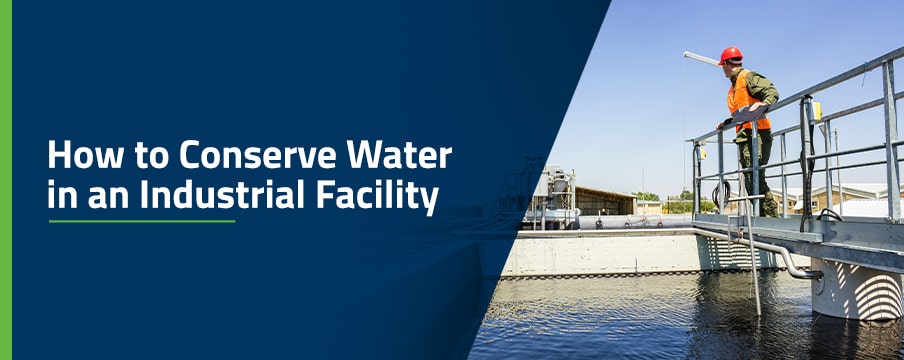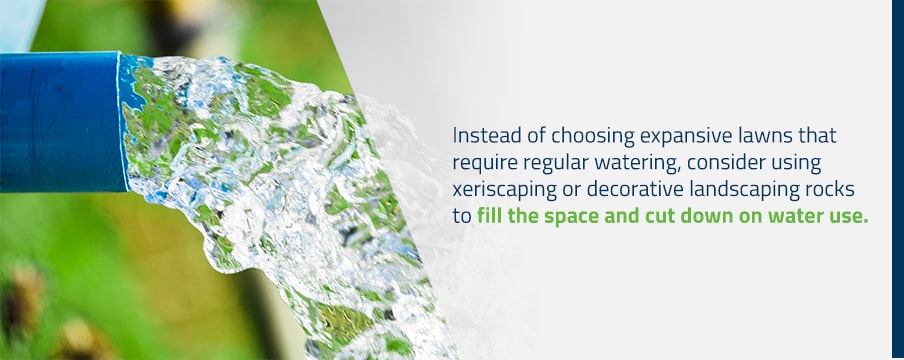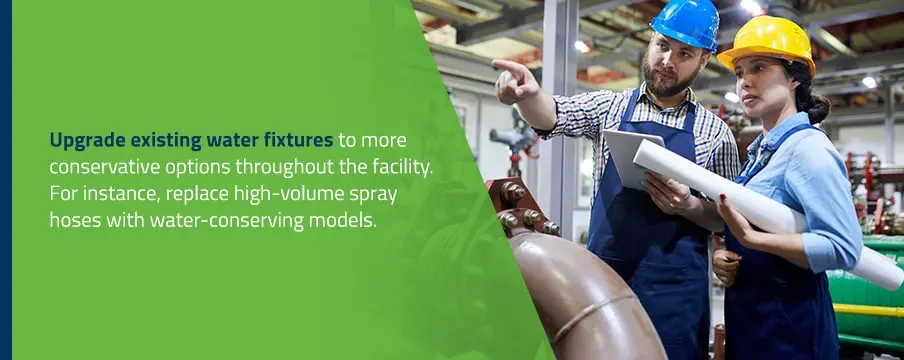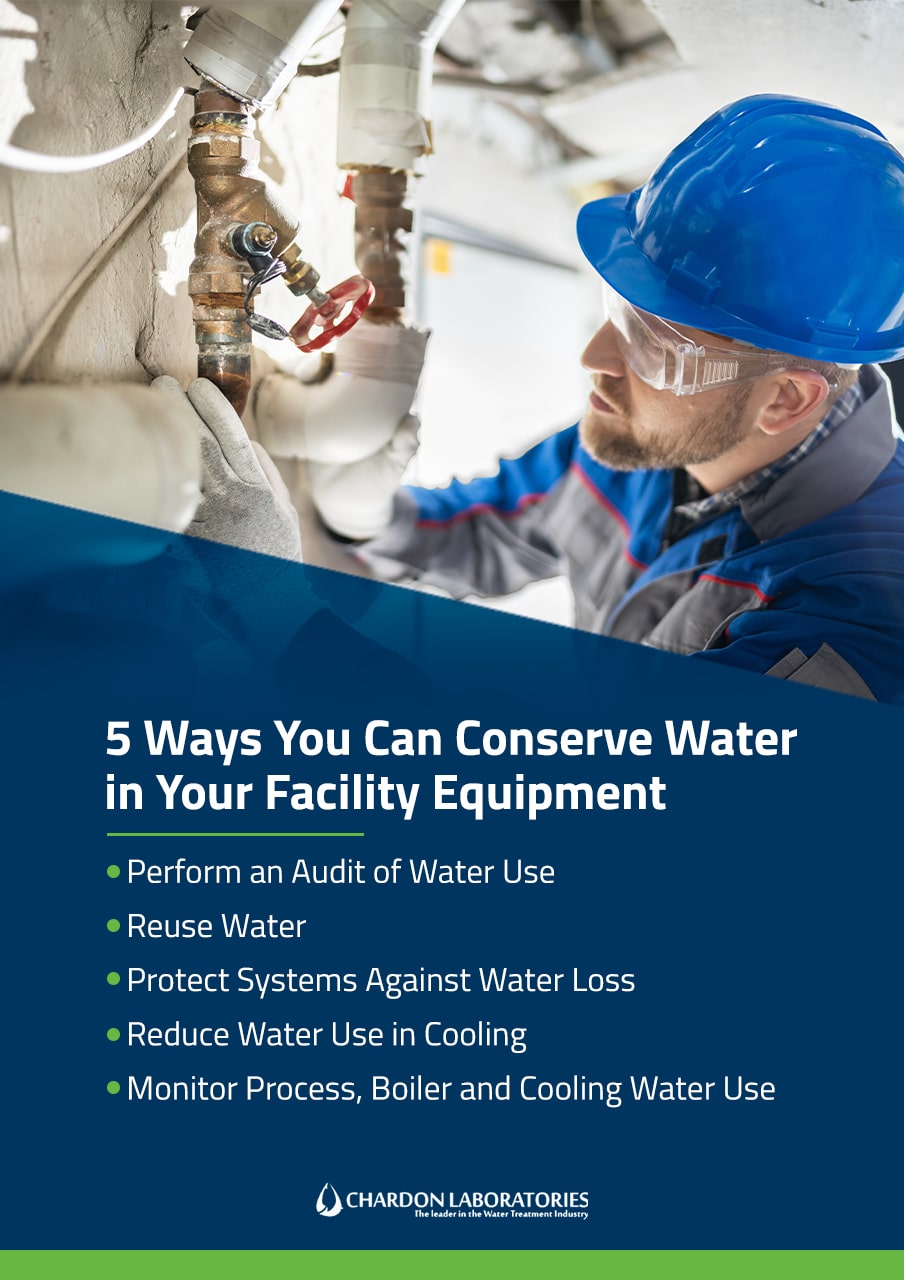
Industrial water consumes a significant proportion of the United States’ freshwater supply. When industrial facilities use their own water, 98% of them use freshwater, accounting for 5% of the country’s total water usage. Consequently, facilities that reduce water use help themselves by saving money on water, water processing and chemical treatment to keep the water clean. Plus, the sites help the rest of the nation preserve the available freshwater for all applications.
Keep reading for more information about numerous water conservation strategies for industrial use.
Conserving water throughout industrial facilities requires thinking on a grander scale than simply updating individual pieces of equipment. Therefore, when planning water conservation, think about ways your business and others in the industry can make changes and how you can adapt your equipment to reduce water use. As a result, your efforts will be more effective.
These three ways to conserve water in industry will provide numerous benefits financially, sustainably and more.

Throughout the facility, reduce any unnecessary water use in the landscape around the site. For instance, instead of choosing expansive lawns that require regular watering, consider using xeriscaping or decorative landscaping rocks to fill the space and cut down on water use. Selecting native plants that are adapted to your area’s precipitation levels and temperatures allows your facility to rely more on rainfall for supplying the plants with their water.
For grass-covered areas, increase the height of the mower to allow the grass to grow taller. Taller grass blades provide shade and reduce water evaporation, which lessens the need for frequent watering. Reducing fertilization of the plants also cuts the need for extra water because fertilizer itself requires water, and it promotes growth that needs extra water. Additionally, use drip irrigation, which is more efficient than broadcast spraying.
Another way to reduce freshwater use in landscaping is to treat wastewater and use it for irrigation or use gray water for plants. Treating wastewater can help lower water use in several areas of the facility, including providing process water or cleaning water.
Any water-reliant equipment should have regular maintenance scheduled for it. Neglecting pipes, water fixtures and other equipment could allow leaks to increase makeup water use. Prioritizing repairs and maintenance means having a regular schedule and monitoring system that detect problems early. If you prioritize maintenance now, you can avoid costly, large-scale repairs later.
Cleaning cooling equipment that uses water is essential. Dust on coils of cooling equipment reduces its efficiency, which increases its water use. Therefore, do your best to make cleaning as much of a priority as maintenance and repairs. Essentially, combining cleaning and inspection chores can reduce downtime and improve the efficiency of water-using systems.
Additionally, you should work with the company where you source boiler, cooling tower or closed loop water treatment systems to ensure the pH balance of cooling or process water. When the water is not correctly balanced, corrosion of equipment may occur, causing pinhole leaks that require more makeup water added to the system.
By repairing minor leaks as soon as possible, you minimize water waste. Plus, over time, your facility will conserve water — and with better-maintained systems, you can avoid costly leaks in the first place and prevent the need for more expensive repairs.

Upgrade existing water fixtures to more conservative options throughout the facility. For instance, replace high-volume spray hoses with water-conserving models. Alternatively, choose dry cleaning methods such as brooms instead of using water to spray down surfaces. It’s also smart to reserve water for cleaning situations that cannot use dry cleaning. For example, bottle washing at beverage facilities requires fresh, clean water. However, you don’t have to waste runoff from these processes. Save the wastewater from bottle washing to use as gray water for site irrigation or to return to a water treatment plant for reuse.
Try installing motion-activated faucets and low-flow toilets in employee bathrooms. If your facility treats water onsite with reverse osmosis, consider upgrading the model to a high-efficiency one that wastes less water. By installing equipment to treat wastewater to become nonpotable, reusable water also reduces the overall water use throughout the facility.

Specific equipment such as cooling towers, boilers and closed loop systems can use less water than they currently do. These cooling or processing water systems may need some minor changes to how they operate before you see major returns in water conservation. Explore five specific ways you can use less water in your facility below.
The most important aspect of conserving water from processes and cooling in your facility is knowing how much you use and how much goes to waste. Therefore, the first step in improving water use is conducting an audit. The audit should look at every aspect of industrial water use through cooling towers, boilers or closed loop systems. It should also consider other sources of water use throughout the facility.
Use the audit to look for equipment that can ensure reduced water use without significant impacts on their efficiency. Since water use will likely change throughout the year, repeating the audit in different seasons will provide deeper insights into average water use. For instance, the summer months will typically have higher water use due to increased evaporation from cooling towers or higher water. If processes that use process coolers change during the year, water consumption will also shift.
A water audit may also include analysis of used water to determine the amount of treatment required to permit reuse. For example, contamination of chemicals or metals in the water during its use may require additional treatment to allow for reuse.
The initial audit serves as a baseline to compare future reviews of water usage. Future audits should compare new water use to the original amount to determine the efficacy of water conservation methods.
Many applications of water in industrial facilities have options for reusing water. Examples include condensate from boilers and blowdown water from cooling towers.
Boiler condensate has the benefit of being produced naturally through the process of using the boiler. Plus, the process of creating condensate inside steam lines of a boiler closely mirrors that of distillation. Both processes boil water. The steam condenses back into a liquid form on surfaces. However, by turning into steam, dissolved solids leave the water.
Consequently, boiler condensate has a low level of solids and contaminants means you likely do not need to treat it to reuse it. Reusing condensate cuts down on the makeup water required. However, you will likely need added piping and equipment to reroute the condensate from wastewater to useable water for the boiler. Air conditioners also create condensate you can reuse for boilers or other processes.
Another potential source of reusable water is blowdown water from cooling towers. Note that blowdown water will have a high level of dissolved solids requiring removal before reuse. However, when treated properly, this water may have the potential for use in nonpotable applications.
Finding alternative water sources, such as nearby ponds or lakes to use for single-pass cooling, can also help cut potable water use. A success story of water conservation is at the Mid-Continent Division (MED) Laboratory of the U.S. Environmental Protection Agency (EPA). This facility used up to 10 million gallons annually for single-pass cooling of its facility and equipment.
Instead of using potable water for this purpose, they used water from nearby Lake Superior. The facility cut potable water use by 90% and reduced their sewage use by returning the cooling water to Lake Superior because it didn’t become contaminated from use. Despite these gains, the facility still used a significant amount of potable water for its ice machine. After switching from a single-pass cooling system for its ice machine to an air-cooled model, the MED cut another 283,000 gallons of potable water each year from its use.
Protect your industrial systems against water loss to reduce the need to add water. As noted, fixing leaks is essential. However, preventing leaks is just as critical. The water chemistry plays a role in preventing leaks inside closed loop systems, cooling towers and boilers. For instance, oxygen control and pH regulation chemicals can prevent corrosion inside boilers. Without these chemical additions, dissolved oxygen, scale or acidic water can create leaks through corroding pipes. Even if the leaks don’t cause visible damage from the outside, they can still increase water use over time. Consequently, getting clean water systems is essential to protecting against water loss from leaks.
Another way to prevent water loss is controlling drift from cooling towers. While most of the water loss from these towers comes from evaporation, which transfers heat from the water to the atmosphere, drift can also cause water loss. Using drift eliminators and baffles on the cooling tower can protect against mist formation that drifts off the cooling tower water’s surface.
Lastly, protect against overflow water. In cooling towers, float controls should help maintain the water level in the basin. However, if these don’t function properly, water can increase too much and overflow, resulting in unnecessary losses. Check the cooling tower’s basin for leaks and overflow. If either occurs, repair the basin or the float control equipment to conserve water.
There are different ways of reducing cooling water use — eliminating single-pass cooling and maximizing cycles of concentration for cooling towers.
Eliminating single-pass cooling increases the amount of use gotten from freshwater, thus reducing water and wastewater costs. To eliminate single-pass cooling, consider replacing the cooling with a closed loop system to reuse water. Note that closed loop systems will require specific water treatment chemicals and equipment to keep their components free of corrosion and buildup.
In single-pass cooling equipment that cannot be replaced with closed loop systems, add automatic shut-off valves. These valves stop freshwater from flowing into the system when unnecessary. The extra piece of equipment can prevent the excessive use of potable water for cooling.
Another option for eliminating single-pass cooling is converting to air-cooling for some processes. However, remember that this option may use more energy in some situations or not provide as much cooling. Only choose air-cooling to replace water-cooling if you will not incur higher energy costs or reduced efficiency.
In cooling towers, maximizing the cycles of concentration could also reduce water use. By reducing the frequency of removing blowdown water from the system and adding fresh makeup water, you can lower the potable water your facility uses for the cooling tower. When adjusting cycles of concentration, use caution to balance the water chemistry carefully. Increasing the cycles too much can lead to system corrosion due to an excessive amount of dissolved solids in the water.
While regular audits will give you snapshots of water use and the improvements made from conservation efforts, constant monitoring of systems and components of systems can help you quickly spot problems long before the next audit.
Use monitoring equipment to identify changes in pressure or flow, especially regarding inaccessible pipes that may leak without producing visible effects.
Another way to use monitors to identify water loss is checking the frequency of automated water treatment chemical additions. If your equipment suddenly needs more chemicals than before, it is likely using more makeup water. Suspect a possible source of water loss in the system.
Head water meters installed on boilers can make water conservation possible by monitoring incoming water to allow for more accurate automated chemical additions. These meters improve the efficiency of boilers. Furthermore, keeping track of the values of the water meter can identify times when water use increases, possibly indicating a boiler or pipe leak.
Water conservation saves on water use, sewage costs and water treatment chemical additions. Additionally, by reducing the amount of potable water used for processes, your facility operates to help lower the amount of industrial freshwater used across the country. With contributions from businesses in reducing water use, overall freshwater sources can last longer for consumption by the country’s growing population.
Don’t forget you will also reduce the need for adding water treatment products when taking water conservation steps. Lowering the amount of incoming water needed for cooling, boilers or processes also reduces the amounts of the additives required to balance the pH of the water and keep it clean. Therefore, you must work with your water treatment provider to get the ideal balance of water chemistry in your cooling systems, boilers and process coolers.
When you need a clean water system, trust Chardon Labs to help you with whatever you need to keep the water in proper balance for optimum use. Plus, clean water preserves the equipment it flows through.
Contact us at Chardon Labs to learn more or ask questions.